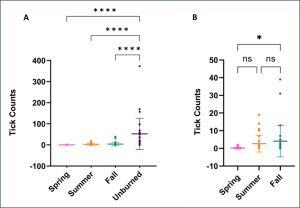Objective: Explore the effect of prescribed fire on tick population dynamics in the Kansas Flint Hills.
Study Description: Ticks were collected from spring (April), summer (August), or fall (September) burned pastures as well as control, unburned areas. Burning had been carried out for four consecutive years prior to this study. Tick populations were sampled every other week from March to August using material dragging and dry ice bait sampling methods. Tick species, sex, and life stage were identified morphologically and the total numbers for each burn treatment were calculated.
Effects of prescribed fire season treatments (spring, summer, fall, and unburned control) on tick counts
A) Comparison between ticks collected from prescribed and unburned areas from each collection event. B) Comparison between the seasonal time of prescribed burn with relation to tick counts. Each dot represents the total number of ticks collected on each sampling day.
*P < 0.05. ****P < 0.0001. ns = not significant. Error bars show standard deviation.
The Bottom Line: Consecutive burning of grazing pasture could be considered an effective tick control treatment to reduce tick abundance in cattle pastures and reduce the need for the use of chemical acaricides on Flint Hills prairie.
The full research report is available. Salazar, Andrea; Griese, Herman; Pickens, Victoria; and Olds, Cassandra (2024) “Reducing Tick Populations Through Prescribed Burning,” Kansas Agricultural Experiment Station Research Reports: Vol. 10: Iss. 1. https://doi.org/10.4148/2378-5977.8554
